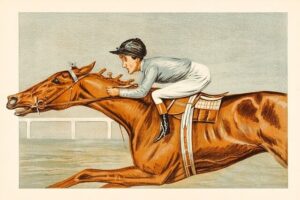 The Tingle Creek Chase is an open Grade 1 steeplechase run over 1 mile, 7 furlongs and 119 yards at Sandown Park in early December. The race was inaugurated, as a limited handicap known as the Benson & Hedges Gold Cup, in 1969, but renamed as the Mecca Bookmakers’ Handicap Hurdle in 1977. Two years later, the race was renamed after Tingle Creek, a bold, front-running steeplechaser who won the Sandown Handicap Pattern Chase three times, in 1973, 1977 and 1978, breaking the course record on each occasion. Indeed, Tingle Creek also won the race that would eventually bear his name under top weight of 12st 5lb in 1973.
The Tingle Creek Chase is an open Grade 1 steeplechase run over 1 mile, 7 furlongs and 119 yards at Sandown Park in early December. The race was inaugurated, as a limited handicap known as the Benson & Hedges Gold Cup, in 1969, but renamed as the Mecca Bookmakers’ Handicap Hurdle in 1977. Two years later, the race was renamed after Tingle Creek, a bold, front-running steeplechaser who won the Sandown Handicap Pattern Chase three times, in 1973, 1977 and 1978, breaking the course record on each occasion. Indeed, Tingle Creek also won the race that would eventually bear his name under top weight of 12st 5lb in 1973.
The Tingle Creek Chase did not become a level-weights Grade 1 race until 1994 but, as the Tingle Creek Handicap Chase, was won by none other than Desert Orchid; on December 3, 1988, ‘Dessie’ had little difficulty in conceding 18lb and upwards all ’round to five rivals, including Panto Prince.
Since 1994, the roll of honor reads like a ‘Who’s Who’ of two-mile chasing talent over the last four decades, with Viking Flagship, Flagship Uberalles, Moscow Flyer, Master Minded and Sprinter Sacre among those to have completed the Tingle Creek Chase/Queen Mother Champion Chase double. Dual Cheltenham Gold Cup winner Kauto Star also won back-to-back renewals of the Tingle Creek Chase in 2005 and 2006. Paul Nicholls, trainer of Flagship Uberalles, Master Minded and Kauto Star – not to mention Dodging Bullets and Politologue, who both also became Champion Chasers – is the leading trainer in the history of the Tingle Creek Chase, with 12 wins in all.

